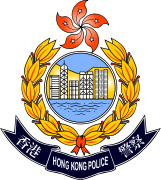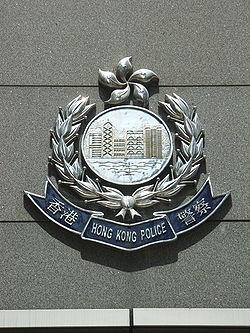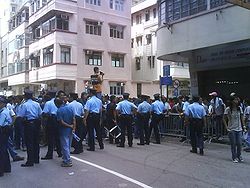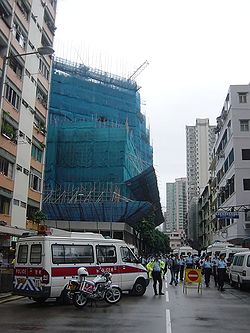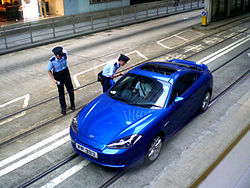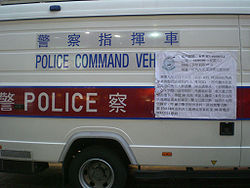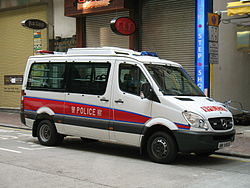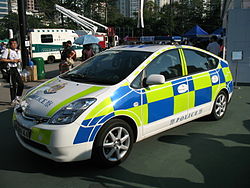- Hong Kong Police Force
-
Hong Kong Police Force
香港警務處Logo of the Hong Kong Police Force
香港警務處.Motto We Serve with Pride and Care Agency overview Formed 1 May, 1844 Employees 37,370 Annual budget HKD12.2 billion Legal personality Governmental: Government agency Jurisdictional structure Governing body [[Security Bureau]] General nature Operational structure Headquarters Hong Kong Police Headquarters
1 Arsenal Street,
Hong Kong Island, Hong KongSworn members 28,191 Elected officer responsible Ambrose Lee, Secretary for Security Agency executive Andy Tsang Wai-hung, Commissioner of Police Website www.police.gov.hk The Hong Kong Police Force (香港警務處, HKPF,alias Hong Kong Police, HKP) is the largest disciplined service under the Security Bureau of Hong Kong. It is the world's second, and Asia's first, police agency to operate with a modern policing system. It was formed on 1 May 1844, with a strength of 32 officers. Queen Elizabeth II granted the Royal Charter to the Hong Kong Police Force in 1969 for their handling of the Hong Kong 1967 riots — renaming them: the Royal Hong Kong Police Force. Following the transfer of sovereignty, the Force is once again named the Hong Kong Police Force.[1]
The current Commissioner of Police is Andy Tsang Wai-hung.[2] Including the Hong Kong Auxiliary Police Force and civil servants, the force consists of about 40,000 personnel; which gives Hong Kong the second largest citizen–police officer ratio in the world.[3] In addition, the Marine Region with about 3,000 officers and a fleet of 143 vessels, is the largest of any civil police force.[4][5][6]
Contents
- 1 History
- 2 Structure
- 3 Ranks and Insignia
- 4 Uniform
- 5 Vehicles
- 6 Firearms
- 7 Special Equipment
- 8 References
- 9 Notes
- 10 External links
History
Main article: History of Hong Kong PoliceThe Hong Kong Police has been serving Hong Kong since shortly after the island was established as a colony in 1841. On 30 April 1841, 12 weeks after the British landed in Hong Kong, Captain Charles Elliot established a police force in the new colony. The first chief of police was Captain William Caine, who also served as the Chief Magistrate.[7]
The 1950s saw the commencement of Hong Kong's 40 year rise to global eminence, during which time the Hong Kong Police tackled many issues that have challenged Hong Kong's stability. Between 1949 and 1989, Hong Kong experienced several huge waves of immigration from mainland China, most notably 1958–62. In the 1970s and '80s, large numbers of Vietnamese boat people arrived in Hong Kong, posing challenges first for marine police, secondly for officers who manned the dozens of camps in the territory and lastly for those who had to repatriate them. The force was granted the Royal Charter in 1969 for their handling of the Hong Kong 1967 riots — renaming them: the Royal Hong Kong Police Force.
The recruitment of Europeans to the force ceased in 1994, and in 1995 the Hong Kong Police became responsible for patrolling the border with China. Prior to 1995, the British Army was responsible for border patrol. 1997 saw Britain's return of the sovereignty of Hong Kong to mainland China. The Force played a prominent role in the handover celebrations and continues to perform flag raising ceremonial duties to this day.
Crest and flag
The current crest of the force was adopted in 1997 to replace the previous crest which contained symbols of British sovereignty. Changes to the crest included:
- St Edward's Crown replaced with a bauhinia flower
- Laurel wreath retained
- The official title of the force was changed from the uni-lingual Royal Hong Kong Police to the bilingual 香港 Hong Kong Police 警察
- Badge image changed from one depicting a junk and British ship in Victoria harbour, to one with a modern view of Hong Kong Island and the modern skyline (Queensway Government Offices, Bank of China Building, City Hall, HSBC Building and Exchange Square). The change was prompted by the concerns of Chinese authorities, who felt the old image was too colonial. Changes to the flag included replacing the Blue Ensign, featuring the old crest, with a single blue flag with the crest centred in the middle.
Structure
The Force is commanded by the Commissioner of Police, who is assisted by two deputy commissioners; a "Deputy Commissioner – Operations" supervises all operational matters including crime and a "Deputy Commissioner – Management" is responsible for the direction and coordination of force management including personnel, training, and management services.
For day-to-day policing (Operations), the Force is organised into six regions:
- Hong Kong Island
- Kowloon East
- Kowloon West
- New Territories North
- New Territories South
- Marine Region
The Force Headquarters (Management) is made up of 5 departments:
- Operations & Support
- Crime & Security
- Personnel & Training
- Management Services
- Finance, Administration and Planning
Regions are largely autonomous in their day-to-day operation and management matters, and each has its own headquarters, which comprises administration and operation wings, Emergency Units, as well as traffic and criminal investigation units. Each region is divided into districts and divisions and, in a few cases, sub-divisions. Currently there are 23 districts. The policing of Hong Kong Island, Kowloon and the main towns of the New Territories follow a similar pattern. Responsibility for law and order on the Mass Transit Railway, which runs through most police districts, is vested in the Railway District.
'A' Department (Operations & Support)
Police Force operational matters are coordinated by the Operations & Support Department. Land Operations and Support are divided into six regions, whereas marine matters are managed by the marine police — organised as one Marine Region. Each land region comprises two wings, the operations wing and support wing, and a traffic headquarters (which is part of the operations wing). The department is charged with the formulation and implementation of policies, the monitoring of activities and the efficient deployment of personnel and resources. Operations Wing coordinates counter terrorism, internal security, anti illegal-immigration measures, bomb disposal commitments and contingency planning for natural disasters — they are also responsible for the Police Dog Unit.
Operations Wing
The Operations Wing consists of three sections: Operations Bureau, the Police Tactical Unit and the Explosive Ordnance Disposal Bureau.
- Operations Bureau: Comprises the Operations Division, the Counter-Terrorism and Internal Security Division, and the Key Points and Search Division which includes the Police Dog Unit. It deals mainly with the staffing of operational matters which include the formulation and dissemination of relevant Force orders, boundary security, deployment of resources and liaison with the Hong Kong garrison.
- Operations Division
- Regional Command and Control Centre provides the means for exercising control over resources both at regional and district levels. It also acts as an information centre for the passage of information to the Headquarters CCC and other agencies. Equipped with the Enhanced Computer Assisted Command and Control System, each Centre receives 999 calls from the public and provides a fast and efficient service to operational officers.
- Emergency Unit comprises the ordinary uniformed policemen. The unit is primarily tasked with regular patrol beats as well as providing quick responses to emergency situations such as 999 calls, as well as a speedy and additional presence of uniformed police on the ground to combat crime. An EU comprises a headquarters element and four platoons which operate on a three-shift basis.
- Operations Division
- Police Tactical Unit
- Explosive Ordnance Disposal Bureau is a special standalone unit within the Operations and Support Wing. Its main responsibilities are bomb disposal work both on land and underwater. It also trains officers on explosives related matters and inspects storage of ammunition and explosives.
- Administration Formation implements policies laid down by the Regional Commander and is responsible for the Region's general administration. Its responsibilities include community relations, staff relations, and magistrates.
- Crime Formation; investigates serious and inter-district crimes. In addition, it collects, collates and evaluates intelligence on criminals and criminal activity within the Region.
- The Traffic Branch Headquarters covers traffic control, enforcement of traffic legislation and regulations, investigation of traffic accidents, promotion of road safety, and implementing Force and Regional traffic policies.
Gallery
-
Officer conducting radar checks at a cross-over bridge in Wan Chai
-
Officers applying traffic control during the 2008 Summer Olympics torch relay
-
Officers applying traffic control during the 2008 Summer Olympics torch relay
-
Force Escort Unit on duty during the 2008 Summer Olympics torch relay
-
Force Escort Unit on duty during the 2008 Summer Olympics torch relay
-
Force Escort Unit on duty during the 2008 Summer Olympics torch relay
Support Wing
There are Support Wings in each of the land regions. A Support Wing oversees the execution and staffing of operational support matters, including the formulation of operational policies for both the regular and Hong Kong Auxiliary Police Force and for updating kits and equipment. It is also responsible for the various licensing functions of the Force. The coordination of all public relations activities is arranged through the Police Public Relations Branch. There are three branches in a support wing:
- Traffic branch Headquarters is responsible for formulating force priorities, policies and procedures on matters related to traffic, coordinating their implementation and monitoring their effects. It processes all traffic prosecutions such as the processing of traffic summons and fixed penalty tickets. It also collects and maintains traffic-related data such as monitoring the changes in traffic legislation. The Traffic Headquarters offers advice on traffic management matters, examines local traffic patterns and new major infrastructure projects. It also formulates, monitors, coordinates and evaluates road safety efforts, enforcement programmes and traffic management schemes. It is also responsible for the administration of the Traffic Warden Corps, who assist the Police in the control of traffic and enforcement of parking offences. It comprises the Traffic Management Bureau, Central Traffic Prosecutions Bureau and Administration Bureau.
- Support Branch is sub-divided into five divisions:
- Field Division is responsible for co-ordinating policy matters relating to firearms, equipment, uniforms and operational procedures. Projects undertaken by the Division during the year included the force-wide introduction of the OC Foam and the new, expandable baton. It had also been instrumental in developing technological solutions to a number of policing problems and is currently conducting a review of police uniforms including the cap and the shoes as well as other accouterments.
- General Division handles policy matters relating to station procedures; the security and management of the Police Headquarters (PHQ) complex; and diverse other duties. During the year, the Division played a major role in the streamlining of station procedures; making arrangements for the reallocation of offices and facilities; formulating a new policy for parking at the PHQ as required by the PHQ Redevelopment Project and such other duties as co-ordinating the Force involvement in the District Council elections.
- Transport Division is responsible for the management and deployment of the Force fleet of approximately 2,400 vehicles, driver establishment and the acquisition of new police vehicles. It also administers all policy matters relating to police transport requirements.
- Force Data and Access to Information Co-ordination Unit is responsible for co-ordinating the Force response to devising internal policy on and ensuring compliance with the provisions of the Personal Data (Privacy) Ordinance and the Code on Access to Information.
- Police Licensing Office acts as the licensing authority for a number of licences and permits.
- Police Public Relations Branch is responsible for maintaining a high level of public confidence by robustly projecting a positive image of the Force through community and media relations. It is sub-divided into two branches:
- Community Relations Bureau
- The Information and Publicity Bureau
'B' Department (Crime & Security)
Crime & Security Department is responsible for the force policy regarding the investigation of crimes and matters of a security nature. Crime Wing consists of a number of operational bureau and specialised units. The operational bureau deal with specific areas of criminal activity whereas the specialised units provide support services to operational units in the force and deal with policy matters on various issues including child abuse, domestic violence and witness protection. Security Wing provides VIP protection and security co-ordination, including counter-terrorism.
Crime Wing
- Organised Crime and Triad Bureau (OCTB) investigates major organised and serious crime involving all types of activities such as theft/smuggling of vehicles, human trafficking, firearms, vice, debt collection, syndicated gambling and extortion. It also investigates triad societies and their hierarchies with particular emphasis on their involvement in organised crime.
- Criminal Intelligence Bureau (CIB) is the Force's central coordinating body for intelligence on crime and criminality which, after analysis and assessment, is disseminated to crime investigation units as required. In addition, the CIB works closely with the OCTB and other Crime Wing bureau in tackling triad and organised crime syndicates. To strengthen the criminal intelligence capability within the Force, the Bureau also organises related training courses and seminars for investigators. Criminal Investigation Division or CID are sub-division located in each district.
- Commercial Crime Bureau investigates serious commercial and business fraud, computer-related crimes, the forgery of monetary instruments, identity documents and payment cards, and the counterfeiting of currency and coins. It liaises very closely with international law enforcement agencies on exchange of intelligence and requests for investigation from other jurisdictions alleging criminal conduct in relation to commercial transactions.
- Narcotics Bureau investigates serious drug cases such as importation and manufacture of illicit drugs, and gathers intelligence in relation to major drug activities. It also conducts investigations in partnership with overseas law enforcement agencies whenever there is a Hong Kong connection to international drug trafficking. The Bureau is also responsible for financial investigations using powers granted under the Drug Trafficking (Recovery of Proceeds) Ordinance, Organised and Serious Crimes Ordinance and the United Nations (Anti-Terrorism Measures) Ordinance.
- Support Group is made up of units which provide a technical and professional service to support criminal investigation, including Criminal Records Bureau, Identification Bureau, Forensic Firearms Examination Bureau, Witness Protection Unit and Child Protection Policy Unit. The group also fulfils a liaison responsibility for the Forensic Pathology Service and the Forensic Science Division.
Security Wing
Is responsible for a range of security-related matters including VIP protection, counter-terrorism and security co-ordination.
'C' Department (Personnel & Training)
- Personnel Wing is responsible for all core human resource management functions, including recruitment, promotion, conditions of service, staff relations and welfare matters.
In recent years, the Personnel Wing has also usurped the near exclusive right in adjudicating disciplinary proceedings brought against Inspectors and Junior Officers. The establishment of a dedicated unit to preside over disciplinary proceedings gave senior officers in the Personnel Wing easy avenues to influence the outcome of the proceedings.
- Hong Kong Police College is responsible for all matters relating to training within the Hong Kong Police except internal security, Auxiliary and Marine Police training. Training provided by the Police College includes recruit and continuation training, crime investigation training, police driver training and weapon tactics training. The information technology training, command training, local and overseas management training, some specialist courses and periodic courses on firearms and first aid are also provided by the Police College.
- Hong Kong Police Band
'D' Department (Management Services)
Information Systems Wing has two branches and one bureau dealing with communications, information technology and business services. Communications Branch designs, acquires, examines and maintains all force communications networks and equipment including radio, video, navigational aids, speed detection radar, mobile phones, pagers, office telephones and mini firing range equipment.
Information Technology Branch is responsible for the planning, development, implementation, operation and maintenance of information technology systems. It has over 10,000 terminals installed throughout Hong Kong supporting the Force in the spheres of command and control, criminal records, crime intelligence analysis, fingerprint identification, reports to Police, human and financial resources planning and management, transport management, licencing, and e-mail.
Business Services Bureau coordinates the business needs of the five departments of the Force. It consists of the Business Services Division, the e-Police Division and the Major Systems Division which acts as the System "Owner" for systems used Force-wide.
Service Quality Wing is responsible for spearheading initiatives to improve services provided to force customers both external and internal. The wing comprises three branches: Performance Review, Research and Inspections and Complaints and Internal Investigations (C&II). The Wing is responsible for implementing the force strategy on 'service quality' which aims at promoting efficiency, effectiveness and economy, whilst pursuing continuous improvement. The C&II Branch which includes the Complaints Against Police Office (CAPO) oversees the investigation and successful resolution of all complaints made both externally and internally against members of the force. The work of CAPO is closely monitored by the Independent Police Complaints Council to ensure that all complaints against police officers and traffic wardens are fully and impartially investigated. The findings of CAPO are seldom challenged by the IPCC.
'E' Department (Finance, Administration & Planning)
Finance Wing is responsible for the financial management, stores and internal audit of the Force. Administration Wing is responsible for civilian staff, force establishment matters and the management of the Police Museum. Planning and Development Branch (P&D) coordinates strategic thinking and planning on options for the operational policing of Hong Kong into the foreseeable future. It is responsible for maintaining and modernising the police estate and for running projects for the construction of new police buildings/facilities.
Ranks and Insignia
The HKPF continues to use similar ranks and insignia to those used in British police forces. Until 1997, the St Edward's Crown was used in the insignia, when it was replaced with the Bauhinia flower crest of the Hong Kong government. The crest of the force was modified in 1997. The rank structure, organisation and insignia are similar to that used by the Metropolitan Police Service until the mid-1970s.[8]
- Commissioner of Police (CP)
- Deputy Commissioner of Police (DCP)
- Senior Assistant Commissioner of Police (SACP)
- Assistant Commissioner of Police (ACP)
- Chief Superintendent of Police (CSP)
- Senior Superintendent of Police (SSP)
- Superintendent of Police (SP)
- Chief Inspector of Police (CIP)
- Senior Inspector of Police (SIP)
- Inspector of Police (IP)
- Probationary Inspector of Police (PI)
- Station Sergeant (SSGT)
- Sergeant (SGT)
- Senior Constable (SPC)
- Police Constable (PC)
Uniform
 Officers in formal dressing (previous winter uniform) to set up the Flags at Golden Bauhinia Square, Wan Chai.
Officers in formal dressing (previous winter uniform) to set up the Flags at Golden Bauhinia Square, Wan Chai.
Hong Kong Police Force uniform currently comprises:
Uniform Branch
Dark navy blue jacket with the words Police, in English and Chinese, in reflective white tape, on the front left breast and back. Light blue shirts are worn by most officers, whilst white shirts are worn by senior officers. Dark blue cargo trousers and black caps are worn by all officers.
Tactical Units
(e.g. EU, PTU and CTRU): Wear uniform identical to Uniform Branch officers, although berets are worn rather than caps and trousers are tucked into boots. Riot helmets are worn for riot control.
Traffic
Reflective yellow jacket and navy blue riding trousers. In warmer weather, reflective vests with white sleeves are an alternative.
Other uniform
- Disruptive Pattern Material (e.g. SBD and SDU)
- Battle Dress Uniform (e.g. SDU)
Retired uniforms
- Summer Uniform: Green Khaki drill tropical shirts and trousers or bermuda style shorts, worn with black Sam Browne Belts. Females wore summer beige shirts with skirts. This uniform was worn until 2004 when the forced switched to a slightly modernised version of the Winter Uniform, to be worn all year round.
- Winter Uniform: Light blue shirts with necktie, worn under a navy blue tunic and Sam Browne Belt, with navy blue uniform trousers.
Vehicles
Main article: Police vehicles in Hong KongMost police vehicles in Hong Kong are white, with a blue and red 3M retroreflective stripe around on the sides of the vehicle with wording "警 Police 察" in white, the only exception being the armoured personnel carriers specially designed for the Police Tactical Unit, which are wholly dark blue and with wording "警 Police 察" on a light blue background in white on the sides of the vehicle. Most police vehicles in Hong Kong are equipped with both red and blue emergency vehicle lighting. The vehicles which are allocated to the Hong Kong International Airport have an additional yellow emergency vehicle lighting. It should be noted that all police vehicle are government property and therefore have a license plate which starts with "AM".
Since 2008, the Hong Kong Police Force have brought in the use of battenburg markings for new police vehicles of the Traffic Branch Headquarters. In addition, these new vehicles show the Force crest on the front part of the vehicle, which the Force has not used in the design of new vehicles for the last two decades.
The Hong Kong Police Force have unmarked police vehicles in order to catch and arrest criminals in the act; such vehicles include the discrete and high performance BMW 5 Series car, among other types. Also, the Force operate unmarked police vehicles for surveillance to gather evidence of any criminal offence. In addition, for security purposes, armoured cars specially designed for the Very Important Person Protection Unit and bulletproof tactical police vehicles specially designed for the Special Duties Unit have no markings also.
Firearms
Model Service Details Glock 17 / Glock 19  Austria
AustriaUsed by SDU,VIPPU,ASU,CTRU,SBDIV,WPU,OCID,CIB,CCB,NB,HKPC。 Sig Sauer P250 Dcc  United States
United States  Germany
GermanyUsed by CIB and HKPC(Hong Kong Police College)(Replacement handgun of Colt Detective Special) Smith & Wesson Model 10  United States
United StatesService Revolver of HKPF。Used by PTU、EU、PSU、QRF and HKPC(Hong Kong Police College)。 Heckler & Koch MP5  Germany
GermanyStandard SMG of HKPF。Variants(A3/A5/K/SD3/K-PDW/SFA2/S-K/S-N)used by ASU、SDU、CTRU、OCID、CIB、VIPPU、EU、SBDIV。 Remington 870  United States
United StatesStandard Shotgun of HKPF。Used by CIB、EU、PTU、SDU(both long and short barrel for SDU only)。 Colt AR-15  United States
United StatesUsed by PTU Benelli M1 Super 90  Italy
ItalyUsed by SDU Heckler & Koch G36KV  Germany
GermanyUsed by SDU Colt M4  United States
United StatesUsed by SDU KAC SR-25  United States
United StatesUsed by SDU Accuracy International L96A1  United Kingdom
United KingdomUsed by SDU SIG Sauer SSG 2000  Switzerland
Switzerland  Germany
GermanyUsed by SDU M16 rifle  United States
United StatesUsed by SDU(A1/A2) Federal M201-Z or M203-A  United States
United StatesUsed by PTU and EU M1911  United States
United StatesUsed by SSU(Surveillance Support Unit)before replaced by Glock 17 and SIG Sauer P250 pistols. Mini 14  United States
United StatesUsed by SSU(Surveillance Support Unit)before replaced by MP5 SMGs Colt Detective Special  United States
United StatesUsed by CIB and HKPC before replaced by replaced by Glock 17 and SIG Sauer P250 pistols. Browning Hi Power  United States
United StatesUsed by ASU,SDU and HKPC before replaced by replaced by Glock 17. Special Equipment
Explosive Ordnance Disposal Bureau
- AB Precision Cyclops EOD ROV
- Wheelbarrow (EOD) robot
References
- ^ Carroll, John M. (2007). A Concise History of Hong Kong. Rowman & Littlefield. ISBN 0-7425-3422-7.
- ^ Hong Kong Police Force. "Hong Kong Police Force - Organization Structure: Senior Officers". http://www.police.gov.hk/ppp_en/01_about_us/os_sofficers.html. Retrieved March 3, 2011.
- ^ List of countries by size of police forces
- ^ Police History: Overview - The Future
- ^ 香港警務處-警隊歷史
- ^ 水警總區
- ^ The First Century
- ^ Rank Insignia of the Metropolitan Police Service
- ^ Rank Insignia of the Hong Kong Police Force
- ^ Hong Kong Police Force - Organisational Chart
Notes
 This article incorporates text from a publication now in the public domain: Hong Kong - The Facts, published by the Information Services Department, Hong Kong Special Administrative Region Government.
This article incorporates text from a publication now in the public domain: Hong Kong - The Facts, published by the Information Services Department, Hong Kong Special Administrative Region Government.External links
- Hong Kong Police Force (English) (Chinese)
- Hong Kong Police College
- History of the Hong Kong Police
- Organization Structure of the HKPF
- Independent Police Complaints Council
- Hong Kong Disciplined Services
Disciplined Services in Hong Kong Disciplined Services[1] Hong Kong Police Force · Fire Services Department · Hong Kong Correctional Services · Customs and Excise Department · Immigration Department · Government Flying ServiceOthers Notes: 1. subordinated to the Security Bureau; 2. under direct control of the Chief Executive Security Bureau (Hong Kong) Auxiliary Medical Service • Civil Aid Service • Correctional Services Department • Customs and Excise Department • Fire Services Department • Government Flying Service • Hong Kong Police Force • Immigration Department
Categories:- Hong Kong Police Force
- Law enforcement agencies of Hong Kong
- Public health and safety in Hong Kong
- Hong Kong government departments and agencies
- Hong Kong-related lists
- National Central Bureaus of Interpol
- Border guards
Wikimedia Foundation. 2010.

